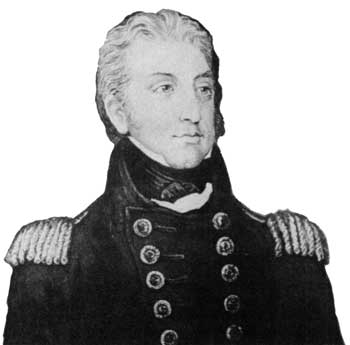|
FORT McHENRY National Monument and Historic Shrine |
 |

Rear Admiral George Cockburn.
From Brenton's Naval History.
The Chesapeake Campaign
Since the bulk of its army was committed to Wellington's Peninsular Campaign, England was compelled to rely principally upon its navy to vanquish the United States. Late in 1812, His Majesty's Government proclaimed a blockade of the Chesapeake and Delaware Bays, and by 1813 the former had been practically converted into a British lake. Under the energetic and ruthless leadership of Rear Admiral George Cockburn, naval detachments raided many of the towns on the Bay and harried their residents. The only opposition to the British was offered by Commodore Joshua Barney's small flotilla of barges and gunboats.
In the summer of 1814, the enemy fleet in the Bay was augmented and placed under the command of Vice Admiral Alexander Cochrane. In addition, the capitulation of Napoleon permitted the War Office to transfer four battle-hardened regiments from the Continent to cooperate with the fleet. Cockburn took this opportunity to advise the army commander, Maj. Gen. Robert Ross, of the defenseless state of the city of Washington, and he urged him to take advantage of the situation.
On August 19, Ross disembarked his forces at Benedict, on the Patuxent River, and on the next day moved his troops slowly toward Washington. In the meantime, a naval party under Cockburn ascended the river and compelled the Americans to burn the remnants of Barney's flotilla. At Upper Marlboro, Ross was joined by Cockburn's naval detachment, and on August 24 the combined force resumed its slow march toward the Capital.
At Bladensburg, the British encountered the army of raw militia which Brig. Gen. William Winder had hastily collected for the defense of Washington. The Battle of Bladensburg represents the nadir of American military effort during the War of 1812. The inexperienced troops, confused by vague and contradictory orders and demoralized by inept leadership, were easily brushed aside by the experienced British regiments. That evening the enemy entered Washington. After a brief period of occupation, during which the Federal buildings were destroyed, Ross moved his troops back to their transports.
Ross and Cochrane then remained for several days off the Patuxent awaiting the return of the warships, which had been detached on special missions. The most successful of these was the feat of Captain Gordon, who led several vessels up the Potomac, collected what amounted to a ransom from the city of Alexandria, and returned safely despite the frequent American efforts to intercept this small squadron.
When all the scattered units had returned, Cochrane ordered the vessels to set sail, and the fleet moved northward up the bay. On September 11, the British dropped anchor at the mouth of the Patapsco just 13 miles below Baltimore, which was their next objective.

|
|
Last Modified: Mon, Dec 2 2002 10:00:00 am PDT |


